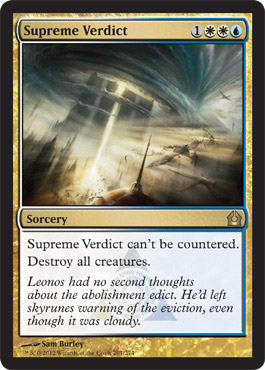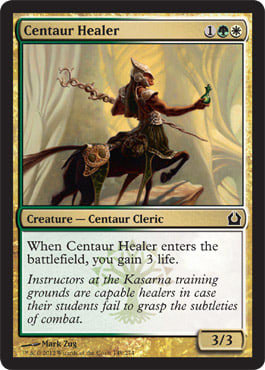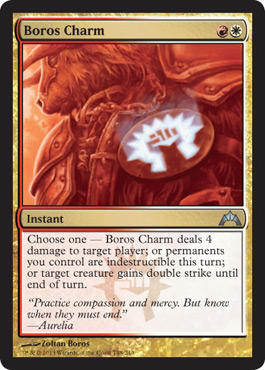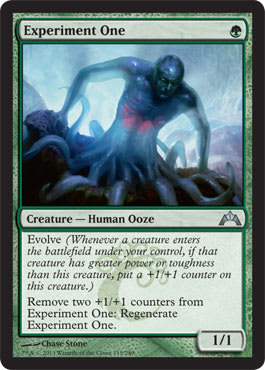Based on the current card pool, I believe that Supreme Verdict and Sphinx's Revelation will be the defining cards of the format. This is not too surprising given that they’re in the same colors as each other, they synergize well together, and they’re so powerful that they’re already among the defining cards of the Standard environment. This would mean that you should do one of three things when building your deck:
- Play with Supreme Verdict and Sphinx's Revelation while making sure that you have a plan against other people doing the same.
- Play a deck that’s so aggressive that you aren’t overly concerned by those two cards, which is much easier said than done.
- Play a deck with ways to potentially deal with/play around those two cards, such as with counterspells or with hand disruption.
With this in mind, I’ve started by designing one deck for each plan. First is my control deck featuring Supreme Verdict and Sphinx's Revelation:
"Bant Control"
- Creatures (12)
- 4 Centaur Healer
- 4 Gatecreeper Vine
- 4 Loxodon Smiter
- Spells (24)
- 4 Azorius Charm
- 4 Selesnya Charm
- 4 Sphinx's Revelation
- 4 Call of the Conclave
- 4 Supreme Verdict
- 4 Detention Sphere
- Lands (24)
- 1 Island
- 4 Forest
- 4 Plains
- 1 Azorius Guildgate
- 1 Selesnya Guildgate
- 1 Simic Guildgate
- 4 Breeding Pool
- 4 Hallowed Fountain
- 4 Temple Garden
I chose to make it three colors because I like what green gives me against beatdown in Game 1 and what it can give me against other control decks after boarding. I hope running fifteen dual lands and four Gatecreeper Vines will allow my mana to be smooth enough. With no 1-drops, I plan to always be playing a land tapped on turn one, and I hope the life-gain from Centaur Healers and Revelations can overcome the pain I will otherwise be taking from playing pain lands untapped.
The plan is to stall the early game with quick beefiness in the form of 3/3 tokens, Loxodon Smiters, and Healers and to back them up with various Charms and Detention Spheres. If/when things get out of hand, I can play Supreme Verdict and then refill my hand with Revelation and start over, hopefully with card advantage and maybe even life advantage. This should give me a good shot against most aggressive decks, but depending on what other types of control decks are in the environment, I may need to sideboard to gain the advantage. I plan to have Urban Evolution and Syncopate in the sideboard to help with various control matchups.
Given the amount of stall and removal in the format, most aggressive decks will be greatly challenged, but I think Boros probably has the best tools to make a breakthrough in what may be a control-heavy environment:
"20-Land Boros"
- Creatures (36)
- 4 Burning-Tree Emissary
- 4 Firefist Striker
- 4 Foundry Street Denizen
- 4 Gore-House Chainwalker
- 4 Hellraiser Goblin
- 4 Legion Loyalist
- 4 Rakdos Cackler
- 4 Skinbrand Goblin
- 4 Skyknight Legionnaire
- Spells (4)
- 4 Boros Charm
- Lands (20)
- 11 Mountain
- 5 Plains
- 4 Sacred Foundry
I’m not a big fan of running decks with only twenty lands, but it’s definitely been proven at this point that an aggressive deck with a low enough curve can be successful in the hands of someone able to make tough mulligan calls. This deck has two main ways of beating an early Supreme Verdict:
- Get a lot of damage in before the Verdict and then follow up with haste creatures and perhaps draw a Boros Charm for finishing damage before a big Revelation can happen.
- Save your creatures with a Boros Charm.
The way this deck is designed, both of these plans are pretty reasonable. Against decks planning to fight me with early creatures, the plan is to quickly get battalion going (which can easily happen by turn three thanks to Emissary, a lot of 1-drops, and a lot of haste creatures) and use Legion Loyalists and Firefist Strikers to push my guys through. Skinbrand Goblins and Boros Charms can also help me win combat phases, the Goblins being especially good when a Loyalist has given my team first strike. As usual, Burning-Tree Emissary is a major star in this deck. Not only does it allow me to make it to Battalion faster, but it pumps up my Foundry Street Denizens more, and it can gain haste when played on turn three with a Hellraiser Goblin.
For the third option, I went with a Simic deck built around evolve:
"Simic Evolution"
- Creatures (28)
- 4 Cloudfin Raptor
- 4 Crocanura
- 4 Deadbridge Goliath
- 4 Experiment One
- 4 Gyre Sage
- 4 Shambleshark
- 4 Zameck Guildmage
- Spells (8)
- 4 Simic Charm
- 4 Syncopate
- Lands (24)
- 10 Forest
- 10 Island
- 4 Breeding Pool
This deck plays a bit like a Counter Sliver deck—you want to tap out the first couple turns to get some pressure on the board, but after that, you want to be very selective about when and if you tap out. This deck has three key cards against Supreme Verdict:
- Experiment One – Not only can the Experiment get a lot of damage in before a Verdict, but it can regenerate—even if you’re tapped out—as long as it has multiple counters, which won’t usually be a problem.
- Zameck Guildmage – This guy is one of the reasons you want to leave mana untapped; if your opponent is getting rid of one of your big dudes, you might as well draw some cards, especially if there is a Verdict on the stack. Hope that the Guildmage can generate you enough card advantage to keep up with Verdicts and Revelations.
- Syncopate – One of the best ways to defeat a Verdict or a Revelation is to stop it from happening. Thankfully, they’re both expensive enough spells that it will usually be pretty easy for you to have enough mana to stop one with a Syncopate. If necessary, a Gyre Sage can sometimes even help out in this regard.
One of the nice things about this deck is that it’s not obvious what you have when you leave 2 mana untapped. Is it a Syncopate, a Simic Charm, a Shambleshark, or just mana for your Guildmage? I think Simic Charm is among the most underused Charms in Standard at the moment. All three options can be powerful in this deck: You can save a Goliath from targeted removal, use the pump to win a combat, or bounce someone else’s giant Experiment.
Return to Ravnica Block Constructed may not end up being as diverse an environment as Standard is currently, but I’m sure there will be viable decks for more than one style of play—and probably not just these three archetypes either. Of course, the addition of Dragon’s Maze may stand the format completely on its head, but it will be good to have some good decks available as starting points. In the meantime, it might just be fun to play with some cool cards you don’t see used in Standard very much, such as Shambleshark or Hellraiser Goblin. For me and perhaps some fortunate among you, now it’s about Pro Tour: Dragon’s Maze or bust!


























